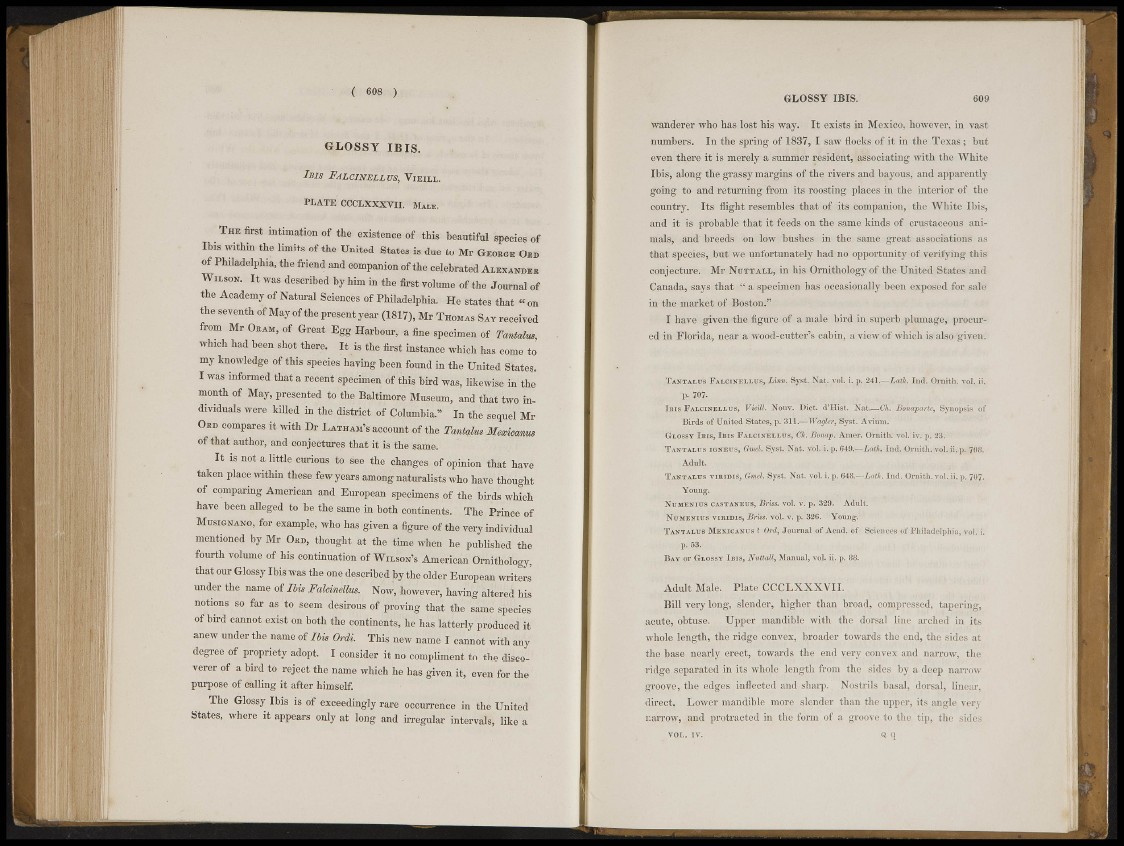
( 608 )
G L O S S Y I B I S .
IBIS FALCWELLUS, Vi e i l l .
PLATB CCCr-XXXVli. Mai«,
The first intimatigli of the e à s t ewMf ,this beautiful species of
I l " s WI t , l i n t l , e of ft® United States is due to Mi George Ob d
of Philadelphia, the friend and companion of the celebrated Alexander
Wilson. I t was describe,1 by him in the first volume of the Journal of
the Academy of Natural Sciences of Philadelphia, « e states that « on
the seventh of May of the present: year (1817), Sir Thomas Say received
f r 0 m M r ° K A M ' u f Great Eg g l a b o u r , * fine specimen » f r a ,Mm,
which had been shot there. It is the first instance whieh has come to
my knowledge of this species having been found in the United States.
I was informed that a recent specimen'of this bM Was, likewise in the
month of -May, presented to the Baltimore Museum, and that two individuals
we® killed in the district of Columbia." In the sequel Mr
Orb compares it-with Dr I. atham's account of the TmttOm Mezicmms
of that author, and conjectures that it is the same.:
I t is not a little curious to see the changes of opinion that have
taken place within these few years among naturalists who have thought
of comparing American and. European specimens of the birds which
have been alleged to be the same:»,both continents,: The Prince of
Mrs.GNASo, for example, who lias given a figure É«he very individual
mentioned by Mr Ord, thought at the time when he published the
fourth volume: of his continuation of Wilson's American Ornithology,
that our Glossy Ibis was (he one described by the older European writers'
under the name of Ibis mdndlrn. liqW, however, having' altered his
notions so far as to seem desiroti? of proving that the same species
of bird cannot, exist on both the continents, la- has latterly produced it
anew under the name of Ibis Ordì. This new name I cannot with any
de.gree of propriety adopt. I consider it no compliment to the discoverer
of a bird to reject the name which he has given it, even for the
purpose of calling it after himself.
The Glossy Ibis is of exceedingly rare occurrence in the United
States, where it appears only at long and irregular intervals, like a
GLOSSY IBIS. 609
wanderer who has lost his way. It exists in Mexico, however, in vast
numbers. In the spring of 1837, I saw flocks of it in the Texas ; but
even there it^-is merely a summer resident, associating with the White
Ibis, along the grassy margins of the rivers and bayous, and apparently
going to and returning from its roosting places in the interior of the
country. Its flight resembles that of its companion, the White Ibis,
and it is probable that it feeds on the same kinds of crustaceous animals,
and broods on low bushes in the same great associations as
that species, but we unfortunately had no opportunity of verifying this
conjecture. Mr Nu t t a l l , in his Ornithology of the United States and
Canada, says that " a specimen has occasionally been exposed for sale
in the market <>f liostou."
I have: given the figure ;>t>a male bird in superb plumage, procured
in Florida, near a wood-cutter's cabin, a view of which is also given.
Ta.ntam-s I-'at..oikkli rs, Linr-. Syst, Nat. vol. i. p. 241.—Latli. Ind. Ori:::h. voi. U.
[bis Falcineleus, VwÀll. N'iniv. Diet. d'His't. Nat.—CA. Bonaparte, Synopsis of
Birds Of United States, p. '.MY^WayUr, Syst. Avium.
G-losst Iris, Iftis FALCiNKtr.us, Ch. ììi-n-xp. Amer. Ornith. vol. iv. p. 23.
Tantalus igVetis, Gmcl.. Syst. Nat. vol. i. p. ÎÎ4ÎJ.—Lath. Ind. Ornith. vol. ii.p. 708.
Tantaltjs virteis, (bnd. Syst. Nat. vol. i. p. 648.—Lath. Ind. Ornith. vol. ii.p, 707.
. Yonng.
XuMENIÙ's CASTANEU8, Tinss. vol. v'. p,329. Adult.
Numekxi"* vtridis, Jfnss. vol. v. p. 326. Young.' ''
Tantalus Mexican us ? Ord., Journal of Acad, of Sciences of Philadelphia, vol. i.
• •
Bay or (.¡lossy Ibis, yuit'il!, Har.'ju:, vol. ii. p. 88.
' Adult Male. Plate CCCLXXXVI I .
Bill very long, slender, higher than broad, compressed, tapering,
¡unite, obtuse. Upper mandible with the dorsal line arched in its
whole, length, the ridge convex, broader towards the end, the sides at
the base nearly, erect, towards the end very convex and narrow, the
ridge, separated in its whole, length from the sides by a deep narrow
groove, the edges inflected and sharp.. Nostrils basal, dorsal, lineai',
direct. Lower mandible more slender than the upper, its angle very
narrow, and protracted in the form of a groove.to the tip, the sides
vol. iv. Q. <i